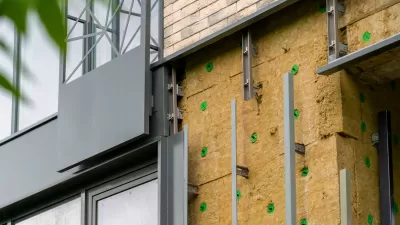Architect David Cook looks at the sustainability craze in building and architecture and warns that calling something "green" doesn't necessarily make it so.
"Increasingly misused in architecture, the term sustainability is in danger of becoming a mere label. In man's relatively short occupation of the Earth, we have succeeded in acutely threatening its future and our habitat. However, we now appear to be gaining a common understanding of the urgency of these matters. Perhaps, for whatever reason, we have finally reached a "tipping point," where we cannot remain in denial. For us sustainability is less a political issue than a humanistic issue; for qualities are just as important as quantities and a "sustainable," or indeed "green," architecture must not solely focus on environmental constraints or pre-defined performance criteria, but also celebrate the wealth and diversity of nature.
Buildings can only be spoken of in sustainable terms if they suit their purpose and are efficient to operate. Otherwise they consume unnecessary resources, are a burden to the owners and risk premature replacement. The process of design requires the consideration of the whole life cycle cost of a building, both in terms of economics and environmental impact; for buildings with a design life of 60 years, the cost of ownership and operation actually far exceeds the cost of construction. Therefore the design approach for any new construction should seek to maximize the efficiency of the building fabric in order to conserve resources in future operation. For us, sustainability in architecture is really about acknowledging the diversity of patterns of use and promoting the wide range of quite subtle, often conflicting, qualities in our built environment. In each project we seek to adopt design strategies which recognize that the building's occupants and their response to their immediate environment as an integral part of these systems."
FULL STORY: Exclusive: David Cook — No, Not the American Idol — Explains What Green Architecture Really Means

Pennsylvania Mall Conversion Bill Passes House
If passed, the bill would promote the adaptive reuse of defunct commercial buildings.

Planning for Accessibility: Proximity is More Important than Mobility
Accessibility-based planning minimizes the distance that people must travel to reach desired services and activities. Measured this way, increased density can provide more total benefits than increased speeds.

World's Largest Wildlife Overpass In the Works in Los Angeles County
Caltrans will soon close half of the 101 Freeway in order to continue construction of the Wallis Annenberg Wildlife Crossing near Agoura Hills in Los Angeles County.

Eviction Looms for Low-Income Tenants as Rent Debt Rises
Nonprofit housing operators across the country face almost $10 billion in rent debt.

Brightline West Breaks Ground
The high-speed rail line will link Las Vegas and the Los Angeles area.

Colorado Bans No-Fault Evictions
In most cases, landlords must provide a just cause for evicting tenants.
City of Costa Mesa
Licking County
Barrett Planning Group LLC
HUD's Office of Policy Development and Research
Mpact Transit + Community
HUD's Office of Policy Development and Research
Tufts University, Department of Urban and Environmental Policy & Planning
City of Universal City TX
ULI Northwest Arkansas
Urban Design for Planners 1: Software Tools
This six-course series explores essential urban design concepts using open source software and equips planners with the tools they need to participate fully in the urban design process.
Planning for Universal Design
Learn the tools for implementing Universal Design in planning regulations.


























